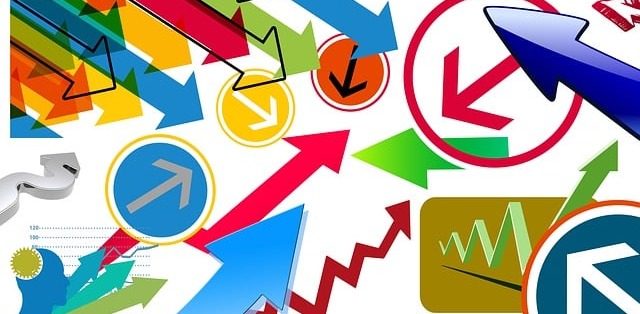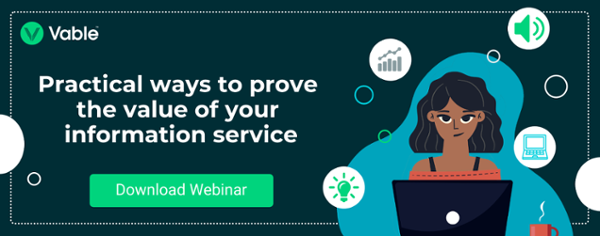Share this
Proving your library's value with ERM: A must-read guide for information managers
November 14, 2023

How do you obtain the data you need to prove the value of your library and information service? We are all data-driven so you need the relevant information at your fingertips. You are on the right track if you have a current awareness aggregator like Vable and an electronic resource management (ERM) tool like ResearchMonitor.
This type of system integration could change the way you approach renewal negotiations, budget proposals, annual reports, business cases - or any other places where comprehensive and accurate data are required. As a reminder, I would like to take you through what an ERM system does and the advantages of such integrated systems.
What is electronic resource management (ERM)?
It is fair to say that ERM tools have been around for a long time. An excellent article from 2010, Electronic Resource Management Systems: Manage Online Library Spend and Increase the Value of the Library explains what they are and what they do:
An ERM system is not simply a database to collate and record information, but rather an active system that interacts with everyone in a firm who uses online services. ERM systems perform three main functions:
- Usage monitoring: recording how people use online services.
- Automatic log-on and access control: central control of passwords and seamless access for researchers.
- Cost recovery: improving the efficiency of existing processes and enabling cost recovery on other services.
At its core, ERM is a suite of software and tools designed to streamline and optimise the management of electronic resources in libraries. These resources encompass a wide range of digital materials, from online databases and e-journals to e-books and multimedia content. ERM ensures that libraries can efficiently acquire, organise, provide access to, and assess the usage of these resources.
Incidentally, what is the difference between digital resource management (DRM)and ERM?
The confusion between digital resource management (DRM) and electronic resource management (ERM) is understandable as they sound similar. However, they refer to different aspects of managing digital content and resources.
Digital resource management (DRM):
- Focus: DRM typically refers to the management and coordination of digital assets or resources within an organisation. This can include digital files like documents, images, videos, and other forms of digital content.
- Purpose: The main goal of DRM is to organise, categorise, store, and retrieve digital content efficiently. It's about ensuring the right content is accessible to the right people at the right time.
- Use Case: In a corporate setting, DRM might involve maintaining an organised digital library of marketing materials, promotional videos, product documentation, or company policies. Law firms may have a use case for court recordings, video evidence, and other digital content.
In essence, while DRM broadly deals with the management of any digital content within an organisation, ERM is specifically focused on the management of subscribed electronic resources, particularly in the context of libraries and educational institutions. The key difference lies in the type of digital content they manage and the specific purposes for which they are used.
What are the benefits of ERM?
ERM empowers library and information services of all shapes and sizes (and budgets) to keep pace with the dynamic nature of digital content, providing a real-time view of resource usage and user preferences. With ERM, information managers can align their collections with user needs, enhance resource access, and importantly, make data-driven decisions.
Here are more benefits in detail.
Contract management: ERM tools excel in contract management, enabling information service managers to track licensing agreements, remember renewal dates, and comply with vendor terms. This proactive approach prevents costly oversights and ensures that you have allocated resources in an optimal way.
Password management: ERM offers convenient password management tools, granting users easy access to databases and firm-wide resources - from mobile or desktop. This eliminates end-user frustration of forgotten credentials and enhances resource accessibility. This has become increasingly important since the rise of flexible and home working,
Centralised requests and end-user training: Users can submit research requests online, providing services with a centralised system to manage inquiries and report statistics, enhancing operational efficiency. You can also track billing and chargeback time demonstrating your direct value. Furthermore, you can review database research queries to identify users who may require additional training.
Ultimately, it is about proving your ROI and finding the right partner
The ability to quantify the impact of your library and information service is crucial for securing support and financial resources from the firm’s c-suite, management or operations committee. ERM tools empower libraries to do just that.
Communicating value: The system provides the data necessary to make a compelling case for the value libraries bring to the organisation. By showcasing data on resource usage, and user engagement, this can influence budget discussions, highlight cost savings, and demonstrate the library's contribution to the firm’s overall success.
Cost control and resource usage: ERM tools prevent out-of-contract costs by directing users to alternative resources when they attempt to access content not covered by current agreements, saving valuable budgetary resources. ERM can identify underutilised resources, helping libraries promote valuable but overlooked databases and e-journals, thus maximising the ROI on subscriptions.
Obviously, ERM tools are not isolated systems but must be seamlessly integrated with other information management solutions. Who should you look at? This depends on the type of your library and information service. For instance, in law, prominent names include ResearchMonitor, OneLog, and Lucidea's LookUp Precision.
The adoption of an ERM has many advantages. The astonishing volume of digital information, the need for streamlined workflows and increasing team efficiency means it has become a necessity. Contact Team Vable to find out more about Vable and ERM integrations.
Share this
- April 2025 (1)
- March 2025 (1)
- October 2024 (1)
- July 2024 (1)
- June 2024 (2)
- May 2024 (2)
- April 2024 (3)
- March 2024 (3)
- February 2024 (4)
- January 2024 (2)
- December 2023 (1)
- November 2023 (2)
- October 2023 (2)
- September 2023 (1)
- August 2023 (3)
- July 2023 (5)
- June 2023 (2)
- May 2023 (2)
- April 2023 (4)
- March 2023 (1)
- February 2023 (1)
- January 2023 (2)
- November 2022 (2)
- September 2022 (2)
- August 2022 (2)
- July 2022 (1)
- June 2022 (1)
- May 2022 (2)
- April 2022 (3)
- March 2022 (1)
- February 2022 (2)
- December 2021 (2)
- November 2021 (2)
- October 2021 (2)
- September 2021 (2)
- August 2021 (2)
- July 2021 (2)
- June 2021 (2)
- May 2021 (1)
- April 2021 (2)
- March 2021 (1)
- February 2021 (3)
- January 2021 (2)
- November 2020 (3)
- October 2020 (1)
- August 2020 (2)
- July 2020 (4)
- June 2020 (1)
- May 2020 (1)
- April 2020 (2)
- March 2020 (2)
- February 2020 (3)
- January 2020 (1)
- December 2019 (2)
- November 2019 (1)
- October 2019 (1)
- September 2019 (1)
- August 2019 (3)
- July 2019 (3)
- June 2019 (3)
- May 2019 (2)
- April 2019 (1)
- March 2019 (2)
- February 2019 (3)
- January 2019 (3)
- December 2018 (1)
- November 2018 (2)
- October 2018 (2)
- September 2018 (1)
- August 2018 (2)
- July 2018 (1)
- June 2018 (2)
- May 2018 (3)
- April 2018 (3)
- March 2018 (1)
- February 2018 (3)
- January 2018 (1)
- November 2017 (1)
- October 2017 (1)
- July 2017 (1)
- April 2017 (2)
- March 2017 (3)
- February 2017 (1)
- January 2017 (1)
- November 2016 (2)
- October 2016 (1)
- September 2016 (1)
- August 2016 (2)
- June 2016 (1)
- May 2016 (1)
- April 2016 (1)

